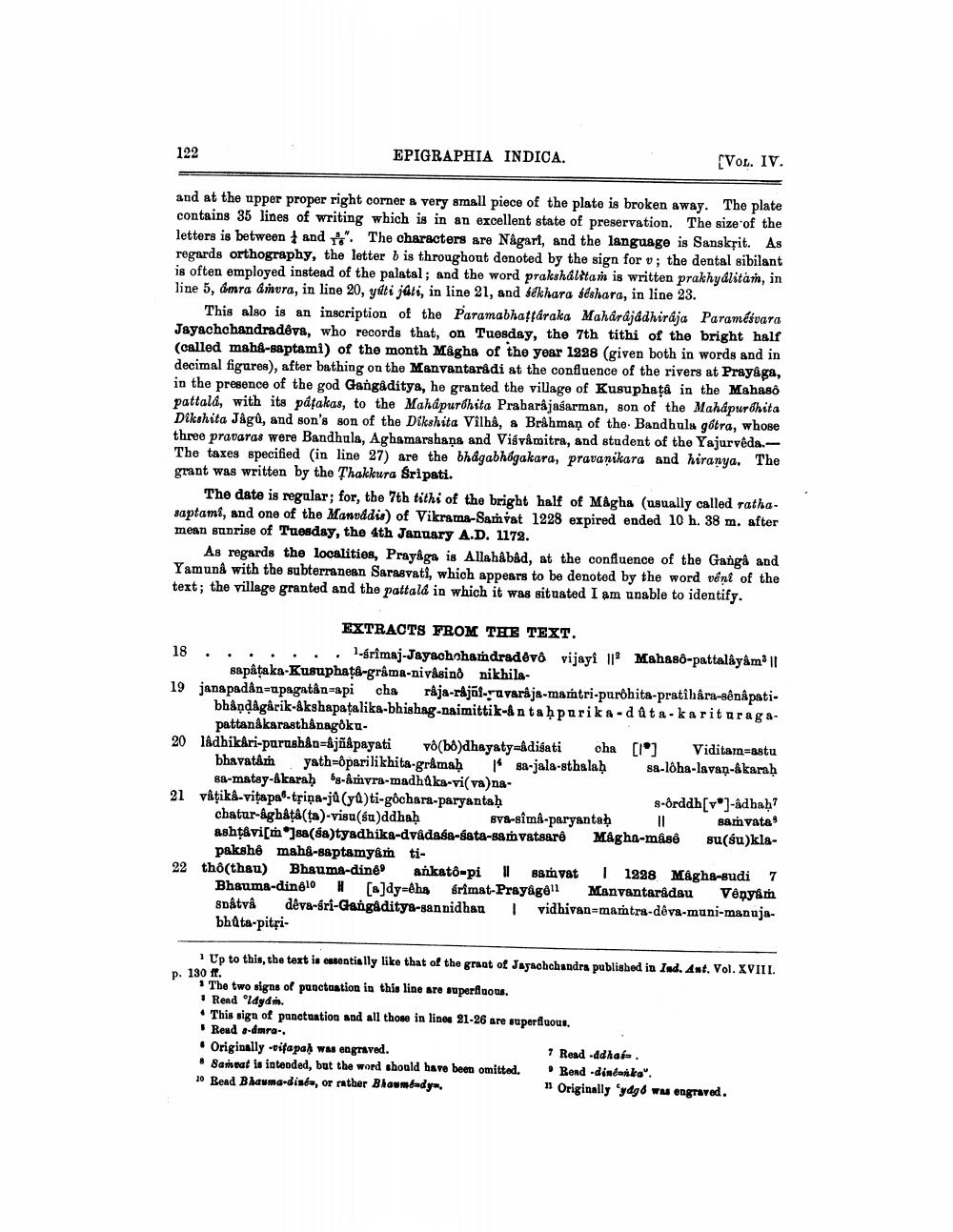________________
122
EPIGRAPHIA INDICA.
(VOL. IV.
and at the upper proper right corner a very small piece of the plate is broken away. The plate contains 35 lines of writing which is in an excellent state of preservation. The size of the letters is between and fa". The characters are Någart, and the language is Sanskrit. As regards orthography, the letter b is throughout denoted by the sign for v; the dental sibilant is often employed instead of the palatal; and the word prakshalitan is written prakhyálitan, in line 5, ámra amura, in line 20, yati juti, in line 21, and šékhara šéshara, in line 23.
This also is an inscription of the Paramabhattaraka Maharajddhiraja Paramésvara Jayachchandradêve, who records that, on Tuesday, the 7th tithi of the bright half (called mahl-saptami) of the month Mâghs of the year 1928 (given both in words and in decimal figures), after bathing on the Manvantarådi at the confluence of the rivers at Prayaga, in the presence of the god Gangaditya, he granted the village of Kusuphata in the Mahasô pattala, with its påfakas, to the Mahapuróhita Prabarâjasarman, son of the Mahápur Chita Dikshita Jågů, and son's son of the Dikshita Vilha, a Bråhman of the Bandhula gótra, whose three pravaras were Bandhula, Aghamarahaņs and Vigvåmitra, and student of the Yajurveda.The taxes specified in line 27) are the bhagabhôgakara, pravanikara and hiranya. The grant was written by the Thakkura Sripati.
The date is regular; for, the 7th tithi of the bright half of Mågha (usually called ratha. saptami, and one of the Manoddis) of Vikrama-Samvat 1228 expired ended 10 h. 38 m. after mean sunrise of Tuesday, the 4th January A.D. 1172.
As regards the localities, Prayaga is Allahabad, at the confluence of the Gangå and Yamuna with the subterranean Sarasvati, which appears to be denoted by the word vén of the text; the village granted and the pattala in which it was situated I am unable to identify.
EXTRACTS FROM THE TEXT. 18 ....... l-srimaj-Jayachchandradêvô vijayi | Mahasô-pattalâyâm ||
sapataka-Kusuphatå-gråma-nivåsind nikhila19 janapadân=apagatân=api cha raja-rajāi-ravarája-mantri-purðhita-pratihára-sênâpati
bhåndâgârik-akshapatalika-bhishag-naimittik-ân tahpurika-data-karitaraga
pattanákarasthånagðku. 20 ladhikari-purushån=&jõ&payati (58)dhayaty=&disati cha [1] Viditam=astu
bhavatâm yath=ôparilikhita-gråmaḥ sa-jala-sthalaḥ sa-lôha-lavan-akaraḥ
Ba-matay-Akaraḥ 6-åmyra-madhaka-vi(va)na21 vatika vitapa-triņa-jů (ya)ti-gôchara-paryantaḥ
s-ôrddh[v*]-ad hah? chatur-&ghatá (ta)-visu(su)ddhah
Sya-sima-paryantab
sam vata ashtåvi[m]sa(ga)tyadhika-dvadasa-sata-samvatsarê Mágha-mâsê su(su)kla
pakshe mahg-Baptamyam ti22 thô(thau) Bhauma-dine ankatô-pi samvat 1228 MÅgha-sudi 7
Bhauma-dinelo # fa]dy-êhs Srimat-Prayage! Manvantarâdau Vênyam spåtvå dêva-sri-Gangaditya-sannidhan vidhivan-mantra-dêva-muni-manujabhůta-pitri
1 Up to this, the text is essentially like that of the grant of Jayachchandra published in Ind. Ant. Vol. XVIII
P. 130 ft.
* The two signs of punctuation in this line are superfluous. • Rend oldydis. • This sign of punctuation and all those in line 21-26 are superfluous.
Read s-dmra. • Originally --ifapah was engraved.
7 Read .ddhar. • Sannat in inteoded, but the word should have been omitted. Rend .dintanka". 20 Read Bhauma-dista, or rather Bhaumdady
1 Originally 'ydg6 was engraved.




